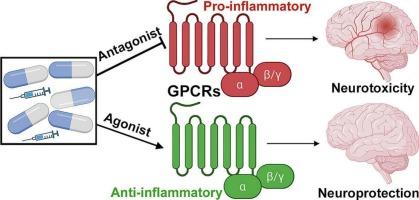神经炎症、神经药理学和治疗学中的g蛋白偶联受体
IF 5.6
2区 医学
Q1 PHARMACOLOGY & PHARMACY
引用次数: 0
摘要
G蛋白偶联受体(gpcr)是通过人类全基因组测序鉴定的七种跨膜(7TM)受体中最具药理针对性的一类。gpcr将细胞外刺激和信号转化为细胞内反应,为生理和体内平衡提供精确的细胞通讯。由于它们能够感知各种配体,gpcr调节了大量的生理功能,如感觉知觉、激素调节和代谢、生长发育、心血管和生殖调节。GPCRs还协调免疫反应,触发平衡的促炎和抗炎信号,这与负责分泌抗感染抗体的b细胞的发育、分化和调节有关。然而,炎症信号的不平衡也与b细胞分化的破坏有关,由于自身抗体水平升高导致自身免疫性疾病。此外,gpcr调节神经传递和突触可塑性,影响行为、情绪和认知功能。由于其不同的功能,据报道,目前fda批准的上市药物中约有40%针对不同的gpcr来获得治疗效果。本综述的重点是gpcr驱动的神经炎症,特别是在神经退行性疾病,如阿尔茨海默病和帕金森病,包括其他疾病。该综述强调了促炎性和抗炎性gpcr在调节疾病病理生理中的作用,包括现有的和新兴的治疗方法。它还为抑制神经炎症介导的神经退行性疾病的替代药物发现提供了未来的路线图。本文章由计算机程序翻译,如有差异,请以英文原文为准。

G-protein coupled receptors in neuroinflammation, neuropharmacology, and therapeutics
The G protein-coupled receptors (GPCRs) represent one of the most pharmacologically targeted classes of seven-transmembrane (7TM) receptors, identified through whole genome sequencing of humans. GPCRs transduce extracellular stimuli and signals into intracellular responses, enabling precise cellular communication for physiology and homeostasis. Given their ability to sense a variety of ligands, GPCRs regulate a plethora of physiological functions, such as sensory perception, hormonal regulation and metabolism, growth and development, cardiovascular and reproductive regulation. GPCRs also orchestrate immune responses, triggering a balanced pro- and anti-inflammatory signaling, which is linked to the development, differentiation, and regulation of B-cells that are responsible for the secretion of infection-fighting antibodies. However, an imbalance in inflammatory signaling is also linked to disruption of B-cell differentiation, leading to autoimmune diseases due to increased levels of autoantibodies. Additionally, GPCRs modulate neurotransmission and synaptic plasticity, influencing behaviour, mood, and cognitive functions. Due to their diverse functionality, ∼40 % of FDA-approved, currently marketed drugs are reported to target different GPCRs for therapeutic benefit. A focal point of this review is GPCR-driven neuroinflammation, particularly in neurodegenerative diseases like Alzheimer’s and Parkinson’s disease, including others. The review highlights the contribution of the pro- and anti-inflammatory GPCRs in modulating the disease pathophysiology, including the existing and emerging therapies. It also provides a future roadmap for alternative drug discovery for suppressing neuroinflammation-mediated neurodegenerative disease.
求助全文
通过发布文献求助,成功后即可免费获取论文全文。
去求助
来源期刊

Biochemical pharmacology
医学-药学
CiteScore
10.30
自引率
1.70%
发文量
420
审稿时长
17 days
期刊介绍:
Biochemical Pharmacology publishes original research findings, Commentaries and review articles related to the elucidation of cellular and tissue function(s) at the biochemical and molecular levels, the modification of cellular phenotype(s) by genetic, transcriptional/translational or drug/compound-induced modifications, as well as the pharmacodynamics and pharmacokinetics of xenobiotics and drugs, the latter including both small molecules and biologics.
The journal''s target audience includes scientists engaged in the identification and study of the mechanisms of action of xenobiotics, biologics and drugs and in the drug discovery and development process.
All areas of cellular biology and cellular, tissue/organ and whole animal pharmacology fall within the scope of the journal. Drug classes covered include anti-infectives, anti-inflammatory agents, chemotherapeutics, cardiovascular, endocrinological, immunological, metabolic, neurological and psychiatric drugs, as well as research on drug metabolism and kinetics. While medicinal chemistry is a topic of complimentary interest, manuscripts in this area must contain sufficient biological data to characterize pharmacologically the compounds reported. Submissions describing work focused predominately on chemical synthesis and molecular modeling will not be considered for review.
While particular emphasis is placed on reporting the results of molecular and biochemical studies, research involving the use of tissue and animal models of human pathophysiology and toxicology is of interest to the extent that it helps define drug mechanisms of action, safety and efficacy.
 求助内容:
求助内容: 应助结果提醒方式:
应助结果提醒方式:


